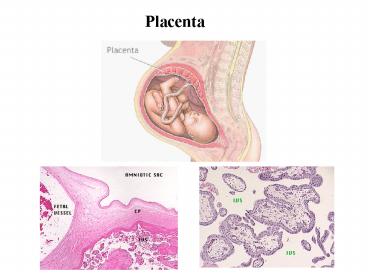Placenta - PowerPoint PPT Presentation
1 / 24
Title: Placenta
1
Placenta
2
Placenta
3
Maternal Adrenal
Placenta
Fetal Adrenal
sulfatase
DHEA-Sulfate
DHEA
a
DHEA-Sulfate
Androstenedione
b
Estrone (3b-OH)
Fetal Liver
c
16a-OH-DHEA-Sulfate
Estradiol (3b17b-OH
sulfatase
16a-OH-DHEA-Sulfate
a
b
c
Estriol (3b17b16a-OH
4
TERATOGENS
- From the Greek word tera, meaning monster
- A physical or chemical agent that causes or
increases - the occurance of a physical defect to a
developing embryo. - Typically an environmental (usually
maternal) effect. - Often not genetic, but individuals may have
a genetically - determined susceptibility.
- Often associated with critical period.
5
Human Teratogens
Tranquilziers - chlorpromazine, meprobamate,
reserpine Sulfonamides - sulfanilamide,
sulfathiazole Barbituates - sodium
barbital, phenobarbital Anti-nausea -
thalidomide Synthetic hormones -
diethylstilbestrol (DES) Alcohol - fetal
alcohol syndrome links Anti-acne -
Accutane
6
Thalidamide Treatment of Rats During Gestation
Thalidamide
conception
Birth (day 20)
day 10
day 12
Limb Deformities
No Effect
7
Critical Period
8
Critical Period
4. Duration of Testing The test
substance should be administered daily throughout
the treatment period. The minimum treatment
period recommended for developmental toxicity
studies is from implantation to Cesarean section
one day prior to the expected day of parturition.
In rats the approximate timing for this period
includes days six through twenty in mice, days
six through eighteen in hamsters, days four
through fifteen and in rabbits, days six through
29. From Guidelines for Developmental Toxicity
Studies, U. S. Food and Drug Administration
9
Relative Maternal-Fetal Toxicity
Non-toxic
lt 1 percent
Retest
Non-toxic
Embryo
Toxic
lt 10 percent
test chemical
Mother
Non-toxic
15 percent
Toxic
Embryo
Toxic
80 percent
10
Pregestational Diabetes Adverse Outcomes of
Pregnancy
Each year, approximately 10,000 infants are
born to women with pregestational diabetes. The
factor most important to the outcome of pregnancy
is how well the mother's glucose level is
controlled before and during pregnancy. When
women with diabetes receive optimal care, the
perinatal mortality rate for their offspring
approaches the corresponding rate for the general
population. However, when pregnant women with
diabetes do not receive expert treatment, the
perinatal mortality rate for their offspring more
than doubles.
11
Fetal Alcohol Syndrome FAS
12
Fetal Alcohol Syndrome FAS
13
Fetal Alcohol Syndrome FAS
14
Meiosis I
Metaphase I
Anaphase I
15
Meiosis Crossing Over
16
Nondisjunction
1
1
1
-1
-1
-1
17
Human Karyotype
Trisomy 21
18
Trisomy
Arhinia Trisomy 9
Downs Trisomy 21
19
Altered Chromosome Structure
20
Inversions
Pericentric
Paracentric
21
Inversions
22
Translocations
23
TDF Translocation
24
Etiology
2 - 3 billion/year to treat congenital anomalies
in US































